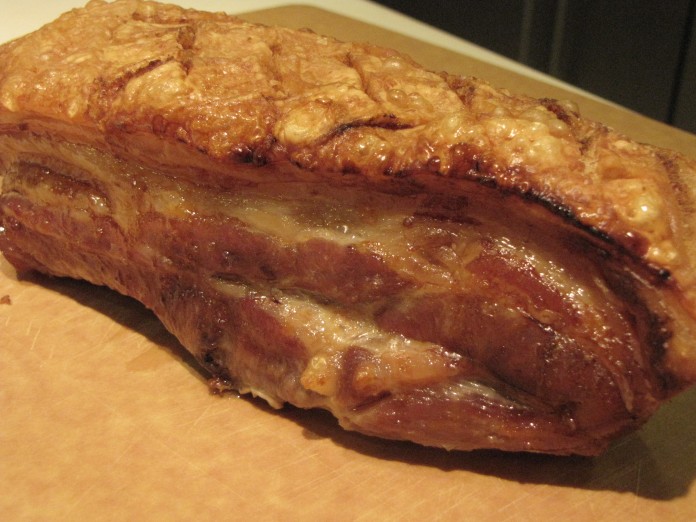If you read this blog, you know that I am no stranger to the pork belly. I’ve heard people say they’re “over pork belly” – fellow food blogger and Vietnamese/dumpling expert Andrea Nguyen noted just the other day that some of her friends made the same peculiar observation – but I’m not, and I never will be. Pork belly, properly prepared, isn’t a fad. It’s a worthy cut of meat, just like loin or shoulder. Why? Because the belly, like other fatty cuts of the pig, tastes like pork. It’s not “the other white meat.” It’s bacon, before it becomes bacon.
I usually like to braise the belly in seasoned stock to reduce its fattiness. Again, belly is, after all, bacon – streaks of meat between layers of fat, and you can achieve a leaner product by braising. Recently, however, I’ve been roasting the belly, which allows the pure flavor of pork to shine. After a few experiments with roast pork belly, I’ve decided that the bone-in, skin-on belly is the way to go when roasting. Unlike the braised product, where the skin becomes unpleasantly rubbery and should be removed before cooking, a roasted belly with the skin yields crispy golden crackling. And unlike braised bellies, which retain moisture through slow, moist cooking in seasoned stock, roasted bellies require the bone. Boneless bellies can become dry on the bottom side, which touches the hot cooking vessel.
Two things about the crackling. One, you need to plan ahead because the secret to golden crisp crackling is a combination of dry pork skin and high heat. Second, to remove as much moisture as possible from the skin, score it or at least perforate the skin with a sharp knife, and rub kosher or sea salt into the skin, working it into the perforations or scorings. Then refrigerate uncovered. Don’t worry about drying out the meat – the amount of fat in the belly will ensure that it stays moist despite its short air drying.
Save the fat that renders from the belly in a tightly sealed container in the refrigerator for a month or so, or indefinitely in the freezer. It’s excellent for confit, for sautéing vegetables, to lend depth to pasta dishes.
Roast pork belly with fennel and braised bunashimeiji mushroom
If you can’t find a bone-in or skin-on belly, don’t worry. The dish will be fine but the belly may become slightly firm on the bottom side. In that case, double the amount of sugar and rub the cure over the entirety of the belly, including the fat on the top side where the skin used to be.
The anise scent of fennel dressed in lemon juice, and pungent fennel pollen, lend a modern Italian character to this dish.
2 lb slab of pork belly, skin on and bone-in
1 tbsp kosher salt, divided
2 tsp superfine sugar
4 sprigs thyme
450F/220C oven.
24 hours before roasting, score the pork skin on the diagonal at 1-cm intervals. Rub 1 tsp of the salt into the scorings. Combine the remaining 2 tsp of the salt and the sugar and coat the pork belly meat evenly. Place the belly in a pan atop 4 sprigs of thyme and refrigerate, uncovered, until 1 hour before roasting time.
After 24 hours, remove the belly and, using a clean kitchen towel, remove as much salt as possible from the skin (most will have been absorbed and the skin should seem quite dry). Oven 450F/230C.
Place the belly in the smallest possible roasting pan. Do not cover and do not place on a rack.
Roast in the 450F oven for 45m( 35m convection). Reduce the heat to 225F/105C and roast for another 1h 45 mins.
Five minutes before removing the belly, turn on the broiler and monitor the belly to ensure that the skin crackles without burning.
Turn off the oven, remove the belly and let it rest about 10 minutes. Using a very sharp knife, slice off the bone and set aside, probably for a snack. The belly will be fall-apart tender. Slice into 1.5″ chunks.
Braised mushrooms
1 lb bunashimeiji and oyster mushrooms, washed well
3 tbsp butter
1/4 c grappa or dry sherry
1/2 c white wine
juice of 1/2 lemon
several sprigs thyme, leaves only
chives, minced
salt (black truffle salt is great) and pepper
Place a deep, heavy pan over medium heat and, when hot, add 2 tbsp butter to the pan. When the butter foams, add the mushrooms, browning well.
Add the grappa to the pan and cook until the mushrooms absorb the liquid; repeat with white wine. Finish with lemon juice, thyme, and stir in the remaining tbsp of butter. Season with salt and black pepper.
Fennel salad
Fennel bulb, shaved with mandoline or benriner
juice of one lemon, strained
pinch fennel pollen, or crushed fennel seeds
salt and pepper
Dress the shaved fennel with a little lemon juice. Season with salt, pepper, and fennel pollen.
To plate:
Plate the mushrooms, top partially with fennel salad, and then a chunk of braised pork belly. Garnish with chives and fennel pollen.



Pingback: Project Food Blog, Part I. « The Upstart Kitchen